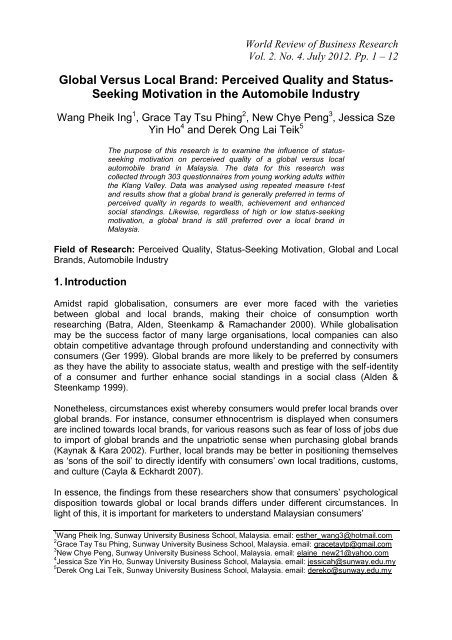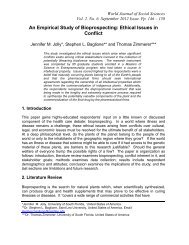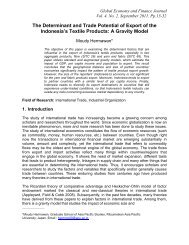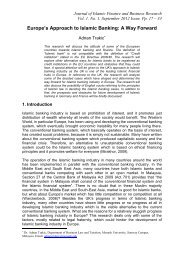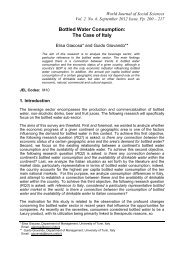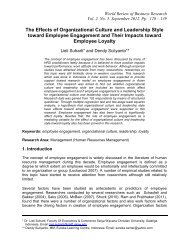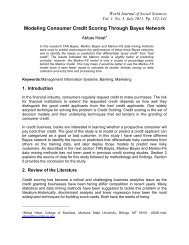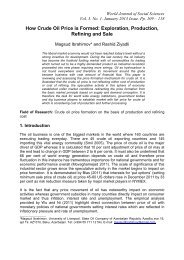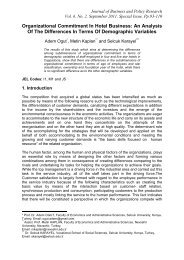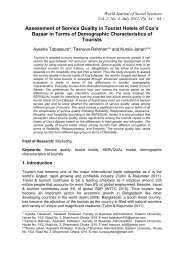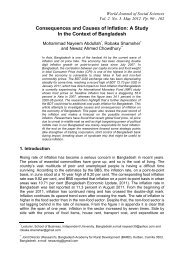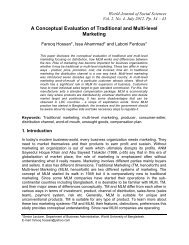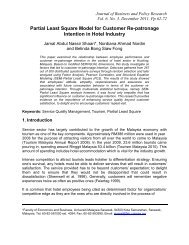Global Versus Local Brand: Perceived Quality and Status- Seeking ...
Global Versus Local Brand: Perceived Quality and Status- Seeking ...
Global Versus Local Brand: Perceived Quality and Status- Seeking ...
You also want an ePaper? Increase the reach of your titles
YUMPU automatically turns print PDFs into web optimized ePapers that Google loves.
World Review of Business Research<br />
Vol. 2. No. 4. July 2012. Pp. 1 – 12<br />
<strong>Global</strong> <strong>Versus</strong> <strong>Local</strong> <strong>Br<strong>and</strong></strong>: <strong>Perceived</strong> <strong>Quality</strong> <strong>and</strong> <strong>Status</strong>-<br />
<strong>Seeking</strong> Motivation in the Automobile Industry<br />
Wang Pheik Ing 1 , Grace Tay Tsu Phing 2 , New Chye Peng 3 , Jessica Sze<br />
Yin Ho 4 <strong>and</strong> Derek Ong Lai Teik 5<br />
The purpose of this research is to examine the influence of statusseeking<br />
motivation on perceived quality of a global versus local<br />
automobile br<strong>and</strong> in Malaysia. The data for this research was<br />
collected through 303 questionnaires from young working adults within<br />
the Klang Valley. Data was analysed using repeated measure t-test<br />
<strong>and</strong> results show that a global br<strong>and</strong> is generally preferred in terms of<br />
perceived quality in regards to wealth, achievement <strong>and</strong> enhanced<br />
social st<strong>and</strong>ings. Likewise, regardless of high or low status-seeking<br />
motivation, a global br<strong>and</strong> is still preferred over a local br<strong>and</strong> in<br />
Malaysia.<br />
Field of Research: <strong>Perceived</strong> <strong>Quality</strong>, <strong>Status</strong>-<strong>Seeking</strong> Motivation, <strong>Global</strong> <strong>and</strong> <strong>Local</strong><br />
<strong>Br<strong>and</strong></strong>s, Automobile Industry<br />
1. Introduction<br />
Amidst rapid globalisation, consumers are ever more faced with the varieties<br />
between global <strong>and</strong> local br<strong>and</strong>s, making their choice of consumption worth<br />
researching (Batra, Alden, Steenkamp & Ramach<strong>and</strong>er 2000). While globalisation<br />
may be the success factor of many large organisations, local companies can also<br />
obtain competitive advantage through profound underst<strong>and</strong>ing <strong>and</strong> connectivity with<br />
consumers (Ger 1999). <strong>Global</strong> br<strong>and</strong>s are more likely to be preferred by consumers<br />
as they have the ability to associate status, wealth <strong>and</strong> prestige with the self-identity<br />
of a consumer <strong>and</strong> further enhance social st<strong>and</strong>ings in a social class (Alden &<br />
Steenkamp 1999).<br />
Nonetheless, circumstances exist whereby consumers would prefer local br<strong>and</strong>s over<br />
global br<strong>and</strong>s. For instance, consumer ethnocentrism is displayed when consumers<br />
are inclined towards local br<strong>and</strong>s, for various reasons such as fear of loss of jobs due<br />
to import of global br<strong>and</strong>s <strong>and</strong> the unpatriotic sense when purchasing global br<strong>and</strong>s<br />
(Kaynak & Kara 2002). Further, local br<strong>and</strong>s may be better in positioning themselves<br />
as ‘sons of the soil’ to directly identify with consumers’ own local traditions, customs,<br />
<strong>and</strong> culture (Cayla & Eckhardt 2007).<br />
In essence, the findings from these researchers show that consumers’ psychological<br />
disposition towards global or local br<strong>and</strong>s differs under different circumstances. In<br />
light of this, it is important for marketers to underst<strong>and</strong> Malaysian consumers’<br />
1 Wang Pheik Ing, Sunway University Business School, Malaysia. email: esther_wang3@hotmail.com<br />
2 Grace Tay Tsu Phing, Sunway University Business School, Malaysia. email: gracetaytp@gmail.com<br />
3 New Chye Peng, Sunway University Business School, Malaysia. email: elaine_new21@yahoo.com<br />
4 Jessica Sze Yin Ho, Sunway University Business School, Malaysia. email: jessicah@sunway.edu.my<br />
5 Derek Ong Lai Teik, Sunway University Business School, Malaysia. email: dereko@sunway.edu.my
Wang, Tay, New, Ho & Ong<br />
behaviour towards these br<strong>and</strong>s in order to create marketing strategies with better fit<br />
for developing nation consumers. Hence, this paper aims to examine the influence of<br />
consumer’s status-seeking motivation on perceived quality of a global versus local<br />
br<strong>and</strong> in the Malaysian context. In terms of research contribution, the current work<br />
adopts <strong>and</strong> extends work (Roy & Chau 2011) which compares consumer-based<br />
br<strong>and</strong> equity <strong>and</strong> status-seeking motivation for a global versus local br<strong>and</strong> in<br />
Australia. In contrast to this contribution, this research adopts a different approach by<br />
pursuing the global versus local br<strong>and</strong> context by primarily focusing on consumers’<br />
status-seeking motivation in pursuing br<strong>and</strong>s for status symbols. As global br<strong>and</strong>s<br />
tend to be preferred when status consumption is a motivator, the work is pursued<br />
more in-depth by further investigating the perceived quality of the global versus local<br />
br<strong>and</strong>. Additionally, the work follows existing recommendations from various<br />
researchers to apply different scales such as Steenkamp’s (2003) perceived br<strong>and</strong><br />
globalness (PBG) scale, status seeking consumption scale (SSC) (Eastman,<br />
Goldsmith & Flynn 1999) <strong>and</strong> the perceived br<strong>and</strong> quality (PBQ) scale (Keller &<br />
Aaker 1992).<br />
This paper contains the following sections. A literature review on the perceived<br />
quality of global <strong>and</strong> local br<strong>and</strong>s in relation to consumers’ status-seeking<br />
consumption is presented in the next section. This is followed by the methodology<br />
<strong>and</strong> findings of the survey. Subsequently, the findings are discussed <strong>and</strong> the<br />
implications are examined. The conclusion is then followed by limitations <strong>and</strong><br />
potential for future research.<br />
2. Literature Review<br />
2.1 <strong>Perceived</strong> <strong>Quality</strong> of <strong>Global</strong> <strong>Versus</strong> <strong>Local</strong> <strong>Br<strong>and</strong></strong><br />
<strong>Perceived</strong> quality is the subjective judgment of consumers towards a product or<br />
br<strong>and</strong>’s superiority <strong>and</strong> distinction (Akram, Merunka & Akram 2011). <strong>Perceived</strong><br />
quality is important in determining consumer preferences towards global <strong>and</strong> local<br />
br<strong>and</strong>s (Milberg & Sinn 2008, as cited in Akram et al. 2011). A global br<strong>and</strong> is defined<br />
from a consumer’s perspective as a br<strong>and</strong> which is believed to be marketed <strong>and</strong><br />
recognised in multiple countries (Steenkamp et al. 2003, cited in Akram et al. 2011).<br />
In turn, a local br<strong>and</strong> is produced domestically for a specific national market <strong>and</strong><br />
usually only obtainable in the particular region (Batra et al. 2000). It is identified that a<br />
local br<strong>and</strong> may be preferred when consumers can identify with others in their<br />
community as the local br<strong>and</strong> is often positioned to underst<strong>and</strong> local needs <strong>and</strong><br />
culture (Cayla & Eckhardt 2007).<br />
On the other h<strong>and</strong>, global br<strong>and</strong>s have been perceived to be of higher quality in<br />
developed <strong>and</strong> developing countries (Batra et al. 2000; Bhardwaj, Kumar & Kim<br />
2010). This is due to the fact that global br<strong>and</strong>s are accepted globally <strong>and</strong> charges a<br />
premium price (Keller 1997; Kapferer 1997). The high perceived quality notion of<br />
global br<strong>and</strong>s is further supported by Milberg <strong>and</strong> Sinn (2008, cited in Akram et al.<br />
2011) <strong>and</strong> Steenkamp et al. (2003, cited in Akram et al. 2011). Steenkamp et al<br />
(2003) further expounded that consumers also regard global br<strong>and</strong>s as having higher<br />
prestige <strong>and</strong> are preferred essentially because of br<strong>and</strong> globalness, in regards to<br />
being internationally desirable <strong>and</strong> dem<strong>and</strong>ed. Additionally, it was found that global<br />
2
Wang, Tay, New, Ho & Ong<br />
br<strong>and</strong>s even appeal to local consumers due to higher perceived quality, status <strong>and</strong><br />
prestige (Batra et al. 2000). Hence, the following hypothesis is proposed:<br />
H1: There is a significant difference between the perceived quality of a global <strong>and</strong><br />
local automobile br<strong>and</strong>.<br />
2.2 <strong>Status</strong>-<strong>Seeking</strong> Consumption <strong>and</strong> the <strong>Perceived</strong> <strong>Quality</strong> of <strong>Global</strong> <strong>Versus</strong><br />
<strong>Local</strong> <strong>Br<strong>and</strong></strong><br />
The most influential factor among social motives for consumer shopping <strong>and</strong><br />
purchasing decision is the enveloping desire for social status (Amaldoss & Jain 2005;<br />
Charles, Hurst & Roussanov 2009; Han, Nunes, & Drèze 2009). Evidently, many<br />
economists have ascertained the desire for status as the fundamental of their<br />
economic analyses (Dusenberry 1949; Veblen 1899) while marketing researchers<br />
have established a long time ago the desire for status as consumers’ primary<br />
motivator for br<strong>and</strong> decision (Martineau 1957). This desire is fuelled by the increasing<br />
levels of affluence worldwide which allows for higher consumption of status goods<br />
(Silverstein, Fiske & Butman 2005). <strong>Status</strong>-seeking consumption occurs without<br />
taking into account the consumer’s income level or social class (Bourdieu 1989;<br />
Eastman et al. 1999; O’Cass & Frost 2002).<br />
<strong>Br<strong>and</strong></strong>s play an integral role in affecting status-seeking consumption as premium<br />
pricing is involved when consuming status br<strong>and</strong>s (Shukla 2010). Moreover,<br />
importance of br<strong>and</strong>s is accentuated in crafting an identity, accomplishment <strong>and</strong><br />
recognition for consumers. Elliot (1997) <strong>and</strong> Elliot <strong>and</strong> Wattanasuwan (1998) further<br />
endorse that br<strong>and</strong>s help construct an emblematic significance <strong>and</strong> develop an<br />
unconscious form of self-identity in a social class. Consecutively, consumers with<br />
dissimilar status-seeking motivation may exhibit unalike preference towards global<br />
<strong>and</strong> local br<strong>and</strong>s (Roy & Chau 2011). In comparison to local br<strong>and</strong>s, some<br />
researchers contend that global br<strong>and</strong>s are likely to be relatively scarce <strong>and</strong> have a<br />
price premium, leading to higher status (Bearden & Etzel 1982). More current<br />
research has also support that scarcity can lead to higher status, hence influencing<br />
consumption choice (Phau & Prendegast 2000, as cited in Roy & Chau 2011). In this<br />
regards, global br<strong>and</strong>s are able to comm<strong>and</strong> higher dem<strong>and</strong>s as status-seeking<br />
consumers are highly likely to consume such br<strong>and</strong>s to improve social st<strong>and</strong>ing<br />
(Veblen 1899; Hannerz 1990).<br />
In Roy <strong>and</strong> Chau’s (2011) study of consumer-based br<strong>and</strong> equity <strong>and</strong> status-seeking<br />
motivation for a global versus local br<strong>and</strong>, it was found that Australian consumers<br />
with high status-seeking motivation perceived a higher quality for global br<strong>and</strong>s while<br />
consumers with low status-seeking motivation perceived no difference in quality<br />
between both br<strong>and</strong>s. While high status-seeking consumers preferred Toyota, the<br />
researchers found that Holden, the local automobile br<strong>and</strong> used in the study, was<br />
preferred by low status-seeking consumers due to its strong local positioning as a<br />
cultural icon. In light of this, this study intends to examine the difference in behaviour<br />
of consumers in Malaysia, a developing country, as compared to the results by Roy<br />
<strong>and</strong> Chau (2011) as it has been found that consumers from emerging <strong>and</strong> developing<br />
economies in general tend to perceive global br<strong>and</strong>s to be of high quality than local<br />
br<strong>and</strong>s (Akram et al. 2011). Studies show that developing country consumers<br />
consume products from Western countries as a symbol of status <strong>and</strong> associate these<br />
3
Wang, Tay, New, Ho & Ong<br />
products with high quality <strong>and</strong> prestige (Bhardwaj et al. 2010, as cited in Akram et al.<br />
2011). Thus, it is proposed that:<br />
H2: There is a significant difference between the perceived quality of a global <strong>and</strong><br />
local automobile br<strong>and</strong> among high status-seeking consumers.<br />
H3: There is no significant difference between the perceived quality of a global<br />
<strong>and</strong> local automobile br<strong>and</strong> among low status-seeking consumers.<br />
Thus far, researches in the area of status-seeking consumption have mainly studied<br />
on automobiles, among other categories like mobile phones <strong>and</strong> designer label wear<br />
(Wong 1997; Eastman et al. 1999; O’Cass & Frost 2002; Amaldoss & Jain 2005). For<br />
the purpose of this research paper, automobile is selected as the category of<br />
research on the status-seeking motivation on perceived quality of a global versus<br />
local br<strong>and</strong>. Mason (1981) further assert that the consumption choice of automobiles<br />
display the consumers’ status, personality <strong>and</strong> self-identity which is additionally<br />
replicated in Amaldoss <strong>and</strong> Jain’s (2005) study.<br />
3. Methodology <strong>and</strong> Research Design<br />
3.1 Data Collection<br />
A survey design was employed to collect data for this research. A total of 303<br />
questionnaires were collected from young working adults within the Klang Valley area.<br />
According to the definition of the Malaysian government, young working adults fall<br />
between the age group of 15 to 40 (Department of Statistics 2008). However, for the<br />
purpose of this research, young working adults will be defined as those aged<br />
between 21 <strong>and</strong> 40 because young adults in this age range are more likely to earn<br />
sufficient income to indulge in status seeking consumption of automobiles. To collect<br />
data, the convenience sampling approach was adopted, <strong>and</strong> questionnaires were<br />
distributed via a web-based survey that provided a link to respondents to access the<br />
questionnaires. An internet snowball procedure, as used in Akram et al.’s (2011)<br />
study of perceived br<strong>and</strong> globalness in emerging markets, was also used for this<br />
research <strong>and</strong> respondents were asked to send the questionnaire link to their contacts<br />
as well.<br />
3.2 Product Selection <strong>and</strong> Instrument<br />
For this study, Toyota was selected to represent a global automobile br<strong>and</strong> while<br />
Perodua was selected to represent a local automobile br<strong>and</strong>. Both Toyota <strong>and</strong><br />
Perodua were selected because they are both best selling br<strong>and</strong>s in the global <strong>and</strong><br />
local arena. In 2010, Toyota maintained its position as best selling global automobile<br />
br<strong>and</strong> with sales st<strong>and</strong>ing at $8.42 million (Datamonitor 2011). Similarly, Perodua<br />
was also acknowledged as the top selling local automobile br<strong>and</strong> in Malaysia,<br />
achieving 188,641 units in sales in 2010 <strong>and</strong> occupying 31.2% of the Malaysian<br />
market share (Carlist.my 2011). Besides that, both br<strong>and</strong>s also share the similarity of<br />
producing compact passenger cars, making it possible to compare between both<br />
br<strong>and</strong>s.<br />
4
Wang, Tay, New, Ho & Ong<br />
The questionnaire used for this research was adapted from various literatures. To<br />
evaluate consumers’ perception of a global or local br<strong>and</strong>, Steenkamp et al.’s (2003,<br />
as cited in Akram at al. 2011) perceived br<strong>and</strong> globalness (PBG) scale was adopted.<br />
For the measurement of status-seeking motivation, Eastman et al.’s (1999) statusseeking<br />
consumption (SSC) scale was employed. This scale has been assessed by<br />
its authors for dimensionality, test-retest reliability, criterion validity, discriminant<br />
validity, nomological validity, internal consistency, <strong>and</strong> freedom from response bias<br />
(Phau & Yip 2008). As for perceived quality, Keller <strong>and</strong> Aaker’s (1992, as cited in<br />
Akram at al. 2011) perceived br<strong>and</strong> quality (PBQ) scale was adopted along with other<br />
questions adapted from several journals to provide a comprehensive measurement<br />
of the variable. A six-point Likert scale, ranging from strongly disagree (1) to strongly<br />
agree (6) was used to measure all the items in the study.<br />
The research model representing all the hypotheses is given in Figure I. This model<br />
is an adaptation of Roy <strong>and</strong> Chau’s (2011) conceptual framework to study consumerbased<br />
br<strong>and</strong> equity. However, this model refines <strong>and</strong> extends the previous model<br />
<strong>and</strong> zooms in on one particular construct of br<strong>and</strong> equity- perceived quality.<br />
Figure 1: Research Framework of <strong>Global</strong> versus <strong>Local</strong> <strong>Br<strong>and</strong></strong> <strong>and</strong> <strong>Status</strong>-<br />
<strong>Seeking</strong> Motivation on <strong>Perceived</strong> <strong>Quality</strong><br />
<strong>Global</strong> versus<br />
<strong>Local</strong> <strong>Br<strong>and</strong></strong><br />
3.3 Pretesting<br />
<strong>Status</strong> <strong>Seeking</strong><br />
Motivation<br />
H2 H3<br />
H1<br />
<strong>Perceived</strong> <strong>Quality</strong><br />
A pilot test was conducted with 35 respondents before distributing the final version of<br />
the questionnaire. Using SPSS software v.19.0, collected pilot data was subjected to<br />
reliability <strong>and</strong> normality testing prior to hypothesis testing. Based on this measure, it<br />
has been found that all the variables demonstrated good reliability with Cronbach<br />
alpha of minimum 0.7 (Nunnally 1978). <strong>Status</strong>-seeking motivation recorded a<br />
Cronbach alpha of 0.749 while perceived quality of both Toyota <strong>and</strong> Perodua<br />
recorded a Cronbach alpha of 0.943 <strong>and</strong> 0.959 respectively, indicating sound<br />
reliability for all variables. In order to perform the repeated measures t-test, the<br />
assumption of normality must be met (Coakes, Steed & Ong 2009). Both perceived<br />
qualities for Toyota <strong>and</strong> Perodua, <strong>and</strong> status-seeking motivation recorded normal<br />
distribution when assessed using histograms, skewness <strong>and</strong> kurtosis, normal<br />
probability plots <strong>and</strong> detrended normal plots.<br />
Before analysing the data, some data were subjected to recoding. A median split was<br />
performed to divide the respondents into high status-seeking <strong>and</strong> low status seeking<br />
groups. After recoding respondents into two groups (high <strong>and</strong> low status-seeking), it<br />
was found that 150 respondents (49.5%) with scores of 3.41 <strong>and</strong> above were<br />
5
Wang, Tay, New, Ho & Ong<br />
categorised as high status-seeking consumers while 153 respondents (50.5%) were<br />
categorised as low status-seeking consumers. The median of 3.40 was used to<br />
separate the data.<br />
4. Findings<br />
4.1 Respondents Profile<br />
The respondents constituted of 303 young working adults within the age range of 21<br />
to 40, amongst which 53.1% were male <strong>and</strong> 46.9% were female. Respondents were<br />
divided into 4 age groups, <strong>and</strong> it was found that 51.4% of respondents were aged<br />
between 21 <strong>and</strong> 25; 17.5%-were aged between 26 <strong>and</strong> 30; 13.5% were aged<br />
between 31 <strong>and</strong> 35; <strong>and</strong> 14.9% were aged between 36 <strong>and</strong> 40. Among the<br />
respondents, a majority were professionals (33.7%), followed by respondents in<br />
managerial (22.8%) <strong>and</strong> clerical (11.9%) positions, as well as respondents who were<br />
self-employed (7.6%). There were also 15.5% of respondents who reported having<br />
other occupations <strong>and</strong> 6.9% who were unemployed. In terms of income level, an<br />
equal proportion (32.3%) of respondents reported a monthly income range of<br />
RM1500 to RM3000 <strong>and</strong> RM3001 to RM5000. Other income ranges of respondents<br />
include those below RM1500 (16.8%), those between RM5001 <strong>and</strong> RM7000 (10.9%),<br />
those between RM 7001 <strong>and</strong> RM9000 (2.6%) <strong>and</strong> those above RM9000 (3.0%).<br />
4.2 Test of Hypotheses<br />
Repeated measures t-test, also known as paired sample t-test, was used to analyse<br />
the data (see Table 1 for results). The first test conducted for hypothesis H1 involved<br />
the entire sample group <strong>and</strong> it was aimed at testing whether the overall perceived<br />
qualities of Toyota <strong>and</strong> Perodua automobiles significantly differed. Based on the<br />
findings, it was found that there is a significant difference between the overall<br />
perceived quality of Toyota automobiles <strong>and</strong> Perodua automobiles. Toyota<br />
automobiles were found to have significantly higher perceived quality than Perodua<br />
automobiles (M= 4.52 versus 3.27; t(302)= 24.595, p
5. Discussion<br />
Wang, Tay, New, Ho & Ong<br />
Using Toyota as representative of a global br<strong>and</strong> <strong>and</strong> Perodua as representative of a<br />
local br<strong>and</strong>, this paper examined how status-seeking motivation <strong>and</strong> the globalness<br />
or localness of a br<strong>and</strong> influence consumers’ perceived quality of automobiles.<br />
Results in this study showed that, as a whole, respondents perceived Toyota as<br />
having higher quality as compared to Perodua. The results obtained validates<br />
findings from other authors who also ascertained that perceived global br<strong>and</strong>s tend to<br />
be of higher quality compared to local ones in emerging <strong>and</strong> developing countries<br />
such as Malaysia (Abdul-Aziz & Wong 2011). Another reason for consumers’ belief in<br />
higher quality of global br<strong>and</strong>s is the global acceptance of such br<strong>and</strong>s (Kapferer<br />
1997, as cited in Roy & Chau 2011). Also, Milberg <strong>and</strong> Sinn (2008, as cited in Akram<br />
et al. 2011) stated that global br<strong>and</strong>s are synonymous with quality for consumers.<br />
Table 1: <strong>Perceived</strong> <strong>Quality</strong> Difference for <strong>Global</strong> <strong>Versus</strong> <strong>Local</strong> <strong>Br<strong>and</strong></strong><br />
Repeated Measures T-Test<br />
Variable <strong>Br<strong>and</strong></strong><br />
Mean Std.<br />
Dev<br />
t df<br />
Sig.<br />
(Two<br />
Tailed)<br />
Mean<br />
Difference<br />
Overall <strong>Perceived</strong><br />
<strong>Quality</strong><br />
Toyota<br />
Perodua<br />
4.52<br />
3.27<br />
0.619<br />
0.794<br />
24.595 302 0.000 1.25<br />
<strong>Perceived</strong> <strong>Quality</strong><br />
of High <strong>Status</strong>-<br />
<strong>Seeking</strong><br />
Consumers<br />
Toyota<br />
Perodua<br />
4.54<br />
3.29<br />
0.641<br />
0.856<br />
17.071 149 0.000 1.25<br />
<strong>Perceived</strong> <strong>Quality</strong><br />
of Low <strong>Status</strong>-<br />
<strong>Seeking</strong><br />
Consumers<br />
Toyota<br />
Perodua<br />
4.50<br />
3.26<br />
0.599<br />
0.731<br />
17.667 152 0.000 1.24<br />
When respondents were divided into two groups- high status-seeking <strong>and</strong> low statusseeking,<br />
it was found that for the high status-seeking group, Toyota automobiles had<br />
significantly higher perceived quality than Perodua automobiles. This is in line with<br />
findings from other authors who stated that high status-seeking groups consume<br />
global br<strong>and</strong>s because of their associations with high status <strong>and</strong> high prestige<br />
(Friedman 1990, as cited in Roy & Chau 2011). Also, high status seeking consumers<br />
prefer global br<strong>and</strong>s because it does not only indicate wealth but also achievement<br />
(Shukla 2008). This study also agrees with Kwak <strong>and</strong> Sojka (2010) in showing how<br />
br<strong>and</strong>s can reinforce individual identity, give a sense of achievement, <strong>and</strong> be an<br />
indicator of social status.<br />
Similar to the high status-seeking group, the low status-seeking group was also<br />
found to perceive Toyota as having higher quality than Perodua. However, this result<br />
contradicts the third proposition (H3) which predicted that there is no significant<br />
difference between the perceived quality of a global <strong>and</strong> local automobile br<strong>and</strong><br />
among low status-seeking consumers. This is in contrast to findings in the study by<br />
Roy <strong>and</strong> Chau (2011) which indicated that high status-seeking consumers tend to<br />
prefer global br<strong>and</strong>s when it comes to perceived quality while no significant<br />
7
Wang, Tay, New, Ho & Ong<br />
difference was indicated for low status-seeking consumers. Nevertheless, the results<br />
could be justified as consumers in general tend to prefer global br<strong>and</strong>s due to its<br />
higher perceived quality <strong>and</strong> higher prestige (Steenkamp et al. 2003, as cited in<br />
Gammoh, Koh & Okoroafo 2011). In addition, global br<strong>and</strong>s are said to be<br />
synonymous with quality for consumers (Milberg & Sinn 2008, as cited in Akram et al.<br />
2011). On top of that, global br<strong>and</strong>s often have advertising messages associated with<br />
promoting higher quality (Batra et al. 2000; Batra & Alden 2002, as cited in Akram et<br />
al. 2011). Thus, the result findings can be attributed to Toyota’s monumental success<br />
in marketing itself to the entire market as a high quality br<strong>and</strong>, regardless among high<br />
or low status-seeking groups.<br />
6. Implications<br />
The results from this study demonstrate that both high <strong>and</strong> low status-seeking<br />
consumers perceived global br<strong>and</strong>s as having higher quality. Consumers attribute<br />
higher quality to global br<strong>and</strong>s as such quality is assumed to be critical to global<br />
acceptance <strong>and</strong> the promotion of higher purchase likelihood (Pappu et al. 2007, as<br />
cited in Roy & Chau 2011). The importance of quality is further emphasised by Holt<br />
et al. (2004, as cited in Gammoh et al. 2011) who found that an average of 44% of<br />
br<strong>and</strong> preference was attributed to quality, showing that perceived quality has a<br />
significant direct association with consumer preference of global br<strong>and</strong>s. This trend of<br />
global br<strong>and</strong> preference is mostly due to the rapid advancement in information <strong>and</strong><br />
communications technology especially the internet <strong>and</strong> transportation, as well as<br />
declining world trade barrier, creating potential global consumer segments (Hassan &<br />
Katsanis 1994, as cited in Gammoh et al. 2011).<br />
The findings from this study also further supports the theory of global versus local<br />
br<strong>and</strong>ing by exemplifying how consumers’ choice may be motivated by psychological<br />
factors such as status-seeking motivation (O’Cass & McEwen 2004; Roy & Chau<br />
2011). This study agrees with Kwak <strong>and</strong> Sojka (2010) in showing how br<strong>and</strong>s can<br />
reinforce individual identity, give a sense of achievement, <strong>and</strong> be an indicator of<br />
social status. Additionally, in an apparel study, respondents rated people who wore a<br />
global br<strong>and</strong> name clothing more highly than people who wore an ordinary store<br />
br<strong>and</strong> (Workman 1988, as cited in Kwak & Sojka 2010). That being said, a high<br />
status-seeking person would buy globally br<strong>and</strong>ed items so that others will view them<br />
as having a higher status <strong>and</strong> in turn, improve his or her social st<strong>and</strong>ing (Veblen<br />
1899, as cited in Roy & Chau 2011; Hannerz 1990, as cited in Roy & Chau 2011).<br />
Relating this to the current study, consumers would buy Toyota instead of Perodua<br />
because they want to be seen as having a superior status in the society.<br />
The information obtained from this study has significant implications for marketers as<br />
it amplifies the importance of pursuing a global strategy for automobile companies<br />
(Phau & Yip 2008). Taking Perodua as an example, while it is considered a local<br />
br<strong>and</strong>, it has a joint venture with Daihatsu Motor Co. Ltd. (DMC) which is a subsidiary<br />
of Toyota. Having this strategic partnership with another global br<strong>and</strong> has allowed<br />
Perodua to tap into the technologically advanced facilities <strong>and</strong> manpower expertise of<br />
DMC (Othman & Ghani 2008; Lim 2010). Perodua should further make use of this<br />
partnership by making it widely known that another global br<strong>and</strong> is involved in the<br />
making of their automobiles in their marketing strategy in order to boost consumers’<br />
8
Wang, Tay, New, Ho & Ong<br />
perception towards the perceived quality of Perodua automobiles. By doing so,<br />
Perodua may have a better chance in competing against global br<strong>and</strong>s such as<br />
Toyota.<br />
Based on results in this study, automobile companies should adopt the “Think-<br />
<strong>Global</strong>, Act-<strong>Global</strong>” approach in strategy-making which involves st<strong>and</strong>ardisation<br />
across the world (Thompson et al. 2011, p.222). <strong>Br<strong>and</strong></strong> globalness is judged by<br />
consumers based on availability around the globe with st<strong>and</strong>ardised products, br<strong>and</strong><br />
name, distribution channel, <strong>and</strong> communications (Akram et al. 2011). By going<br />
global, the company will enjoy an increase in market share, which indicates increase<br />
in dem<strong>and</strong> for their products (Huang & Hsieh 2011). With that, the company can<br />
produce with economies of scale, reduce cost per unit <strong>and</strong> increase production<br />
efficiency resulting in serving customers efficiently <strong>and</strong> economically. Most<br />
importantly, compared to local br<strong>and</strong>s, companies with global br<strong>and</strong>s will be able to<br />
penetrate into markets more easily, regardless to high or low status-seeking<br />
consumers. This is supported by Steenkamp et al. (2003) who mentioned that global<br />
br<strong>and</strong>s positioned with a proper strategy will enable them to achieve an enhanced<br />
global image (as cited in Roy & Chau 2011).<br />
This study also shows components related to perceived quality to consumers.<br />
Factors such as reliability, technological advancement, workmanship, attention to<br />
details, durability, repair frequency, workforce quality, designs, performance, comfort,<br />
safety features, <strong>and</strong> built quality contributes to higher perceived quality of consumers.<br />
That being said, besides marketing, automobile companies should also focus on<br />
value-creating activities as such so that consumers will have a better perception of<br />
quality of the br<strong>and</strong> (Wang et al. 2008). By incorporating these factors, it also delivers<br />
a functional benefit such as creating a differentiation from industry competitors<br />
(Wang et al. 2008).<br />
7. Limitations, Further Research <strong>and</strong> Conclusion<br />
The present study suffers from several limitations. Due to time constraint,<br />
respondents were acquired via convenience sampling in Klang Valley instead of<br />
r<strong>and</strong>om sampling throughout Malaysia. The latter would be a better option as a wider<br />
coverage of the population in Malaysia will allow this study to be more representative<br />
of the entire country <strong>and</strong> will provide better usability <strong>and</strong> enhance external validity<br />
(Roy & Chau 2011). Secondly, this study focused on the automobile industry in<br />
Malaysia, generalizability of the results to other automobile industry in other parts of<br />
the world is limited. Future researches are encouraged to replicate the study in other<br />
geographical locations.<br />
With globalisation as a precedential force for companies to succeed in the<br />
marketplace, it has become increasingly important to underst<strong>and</strong> consumers’<br />
perception <strong>and</strong> factors that influence their purchasing behaviour. The concept of<br />
br<strong>and</strong> globality <strong>and</strong> locality is an important source of strategic insight to marketers in<br />
the automobile industry. Overall findings show that the difference between global <strong>and</strong><br />
local automobile br<strong>and</strong> is significant for both high <strong>and</strong> low status-seeking groups.<br />
Consumers are attracted to global br<strong>and</strong>s as global br<strong>and</strong>s are perceived to be of<br />
higher quality. Like many other developing nations, higher perceived quality in global<br />
9
Wang, Tay, New, Ho & Ong<br />
br<strong>and</strong>s is common for developing countries such as Malaysia. Despite this, it is<br />
important for local companies to note that although globalisation helps large<br />
companies such as Toyota, local companies such as Perodua can obtain similar<br />
advantages as well through underst<strong>and</strong>ing <strong>and</strong> connecting with consumers.<br />
References<br />
Akram, A, Merunka, D & Akram, MS 2011, ‘<strong>Perceived</strong> br<strong>and</strong> globalness in emerging<br />
markets <strong>and</strong> the moderating role of consumer ethnocentrism’, International<br />
Journal of Emerging Markets, vol. 6, no. 4, pp. 291-303.<br />
Abdul-Aziz, AR & Wong, SS 2011, ‘Business networks <strong>and</strong> internationalisation of<br />
contractors from developing countries: An explorative study’, Engineering,<br />
Construction <strong>and</strong> Architectural Management, vol. 18, no. 3, pp. 282-296.<br />
Alden, DL & Steenkamp, JEM 1999, ‘<strong>Br<strong>and</strong></strong> positioning through advertising in Asia,<br />
North America <strong>and</strong> Europe: the role of global consumer culture’, Journal of<br />
Marketing, vol. 63, no. 1, pp. 75-87.<br />
Amaldoss, W & Jain, S 2005, ‘Pricing of conspicuous goods: a competitive analysis<br />
of social effects’, Journal of Marketing Research, vol. 42, no. 1, pp. 30-42.<br />
Batra, R <strong>and</strong> Alden, DL 2002, ‘How perceived br<strong>and</strong> globalness creates br<strong>and</strong> value’,<br />
Journal of International Business Studies, vol. 34, no. 1, pp. 53-65.<br />
Batra, R, Ramaswamy, V, Alden, DL, Steenkamp, JEM & Ramach<strong>and</strong>er, S 2000,<br />
‘Effects of br<strong>and</strong> local/non-local origin on consumer attitudes in developing<br />
countries’, Journal of Consumer Psychology, vol. 9, no. 2, pp. 83-95.<br />
Bearden, WO & Etzel, MJ 1982, ‘Reference group influence on product <strong>and</strong> br<strong>and</strong><br />
purchase decisions’, Journal of Consumer Research, vol.9, pp. 183-194.<br />
Belk, RW 1988, ‘Possessions <strong>and</strong> the extended self’, Journal of Consumer<br />
Research, vol. 15, no. 2, pp. 139-168.<br />
Bhardwaj, V, Kumar, A & Kim, Y 2010, ‘<strong>Br<strong>and</strong></strong> analyses of US global <strong>and</strong> local<br />
br<strong>and</strong>s in India: the case of Levi’s’, Journal of <strong>Global</strong> Marketing, vol. 23, no.1,<br />
pp. 80-95.<br />
Bourdieu, P 1989, ‘Social space <strong>and</strong> symbolic power’, Sociological Theory, vol. 7, no.<br />
1, pp. 14-25.<br />
Carlist.my 2011, Perodua is best selling br<strong>and</strong> in Malaysia for 2010 again, viewed 31<br />
October 2011, .<br />
Cayla, J & Eckhardt, GM 2007, ‘Asian br<strong>and</strong>s without borders: regional opportunities<br />
<strong>and</strong> challenges’, International Marketing Review, vol. 24, no. 4, pp. 444-456.<br />
Charles, KK, Hurst, E & Roussanov, N 2009, ‘Conspicuous consumption <strong>and</strong> race’,<br />
Quarterly Journal of Economics, vol. 124, no. 2, pp. 425–467.<br />
Coakes, SJ, Steed, L & Ong, C 2009, SPSS version 16.0 for Windows: Analysis<br />
without anguish, John Wiley & Sons Australia, Ltd, Australia.<br />
Datamonitor 2011, <strong>Global</strong> top 10 automobile companies report: Industry, financial<br />
<strong>and</strong> SWOT Analysis, viewed 31 October 2011,<br />
.<br />
10
Wang, Tay, New, Ho & Ong<br />
Department of Statistics 2008, Special Release Migration Survey - Geographical<br />
mobility of young adults in Malaysia, vol. 3, no. 1, Department of Statistics,<br />
viewed 31 October 2011,<br />
.<br />
Dusenberry, JS 1949, Income, saving <strong>and</strong> the theory of consumer behaviour,<br />
Harvard University Press, Cambridge.<br />
Eastman, JK, Goldsmith, RE & Flynn, LR 1999, ‘<strong>Status</strong> consumption in consumer<br />
behaviour: scale development <strong>and</strong> validation’, Journal of Marketing Theory <strong>and</strong><br />
Practice, vol. 7, pp. 41-51.<br />
Elliott, R 1997, ‘Existential consumption <strong>and</strong> irrational desire’, European Journal of<br />
Marketing, vol. 34, no. 4, pp. 285-296.<br />
Elliott, R & Wattanasuwan, K 1998, ‘<strong>Br<strong>and</strong></strong>s as symbolic resources for the<br />
construction of identity’, International Journal of Advertising, vol. 17, no. 2, pp.<br />
131-144.<br />
Ger, G 1999, ‘<strong>Local</strong>izing in the global village: local firms competing in global<br />
markets’, California Management Review, vol. 41, pp. 64-83.<br />
Gammoh, BS, Koh, AC & Okoroafo, SC 2011, ‘Consumer culture br<strong>and</strong> positioning<br />
strategies: an experimental investigation’, Journal of Product & <strong>Br<strong>and</strong></strong><br />
Management, vol. 20, no. 1, pp. 48-57.<br />
Han, YJ, Nunes, JC & Drèze, X 2009, First impressions: <strong>Status</strong> signaling using br<strong>and</strong><br />
prominence, Working Paper Series No. 09-107, Marketing Science Institute,<br />
Cambridge, MA.<br />
Hannerz, U 1990, ‘Cosmopolitans <strong>and</strong> locals in world culture’, Theory, Culture <strong>and</strong><br />
Society, vol. 7, pp. 237-251.<br />
Huang, HY & Hsieh, MH 2011, ‘An international br<strong>and</strong>ing strategy based on a case<br />
study of a Taiwanese firm’, Marketing Intelligence & Planning, vol. 29, no.6, pp.<br />
611-623.<br />
Kapferer, JN 1997, Strategic br<strong>and</strong> management: New approaches to creating <strong>and</strong><br />
evaluating br<strong>and</strong> equity, NH: Kogan Page, Dover.<br />
Kaynak, E & Kara, A 2002, ‘Consumer perceptions of foreign products: an analysis of<br />
product-country images <strong>and</strong> ethnocentrism’, European Journal of Marketing,<br />
vol. 36, no. 7-8, pp. 928-949.<br />
Keller, KL 1997, Strategic br<strong>and</strong> management: Building, measuring <strong>and</strong> managing<br />
br<strong>and</strong> equity, NJ: Prentice-Hall, Upper Saddle River.<br />
Keller, KL & Aaker, D 1992, ‘The effects of sequential introduction of br<strong>and</strong><br />
extensions’, Journal of Marketing Research, vol. 29, no. 1, pp. 35-50.<br />
Kwak, LE & Sojka, JZ 2010, ‘If they could see me now: immigrants' use of prestige<br />
br<strong>and</strong>s to convey status’, Journal of Consumer Marketing, vol. 27, no. 4, pp.<br />
371-380.<br />
Martineau, P 1957, Motivation in advertising: Motives that make people buy,<br />
McGraw-Hill, New York.<br />
Mason, R 1981, Conspicuous consumption: A study of exceptional consumer<br />
behaviour, Palgrave Macmillan, Gower Farnborough.<br />
McCraken, G 1988, Culture <strong>and</strong> consumption, Indiana University Press, Bloomington<br />
<strong>and</strong> Indianapolis.<br />
Milberg, SJ & Sinn, F 2008, ‘Vulnerability of global br<strong>and</strong>s to negative feedback<br />
effects’, Journal of Business Research, vol. 61, no. 6, pp. 684-90.<br />
11
Wang, Tay, New, Ho & Ong<br />
O’Cass, A & Frost, H 2002, ‘<strong>Status</strong> br<strong>and</strong>s: Examining the effects of non-productrelated<br />
br<strong>and</strong> associations on status <strong>and</strong> conspicuous consumption’, Journal of<br />
Product & <strong>Br<strong>and</strong></strong> Management, vol. 11, no. 2, pp. 67-88.<br />
Pappu, R, Quester, GP & Cooksey, WR 2007, ‘Country image <strong>and</strong> consumer-based<br />
br<strong>and</strong> equity: relationships <strong>and</strong> implications for international marketing’, Journal<br />
of International Business Studies, vol. 38, pp. 726-45.<br />
Phau, I & Prendegast, GP 2000, ‘Consuming luxury br<strong>and</strong>s: the relevance of ‘rarity<br />
principle’, Journal of <strong>Br<strong>and</strong></strong> Management, vol. 8, no. 2, pp. 122-128.<br />
Phau, I & Yip, SL 2008, ‘Attitudes toward domestic <strong>and</strong> foreign luxury br<strong>and</strong> apparel:<br />
A comparison between status <strong>and</strong> non-status seeking teenagers’, Journal of<br />
Fashion Marketing <strong>and</strong> Management, vol. 12, no. 1, pp. 68-89.<br />
Roy, R & Chau, R 2011, ‘Consumer-based br<strong>and</strong> equity <strong>and</strong> status-seeking<br />
motivation for a global versus local br<strong>and</strong>’, Asia Pacific Journal of Marketing <strong>and</strong><br />
Logistics, vol. 23, no. 3, pp. 270-284.<br />
Shukla, P 2008, ‘Conspicuous consumption among middle age consumers:<br />
psychological <strong>and</strong> br<strong>and</strong> antecedents’, Journal of Product & <strong>Br<strong>and</strong></strong><br />
Management, vol. 17, no. 1, pp. 25–36.<br />
Shukla, P 2010, ‘<strong>Status</strong> consumption in cross-national context: Socio-psychological,<br />
br<strong>and</strong> <strong>and</strong> situational antecedents’, International Marketing Review, vol. 27, no.<br />
1, pp. 108-129.<br />
Silverstein, MJ, Fiske, N & Butman, J 2005, Trading up: Why consumers want new<br />
luxury goods <strong>and</strong> how companies create them, Portfolio, New York.<br />
Thompson, AA, Strickl<strong>and</strong>, AJ & Gamble, JE 2011, Crafting <strong>and</strong> executing strategy,<br />
17th edn, McGraw Hill, Singapore.<br />
Veblen, TB 1899, Theory of the leisure class: An economic study of institutions,<br />
Unwin Books, London.<br />
Wang, H, Wei, Y & Yu, C 2008, ‘<strong>Global</strong> br<strong>and</strong> equity model: combining customerbased<br />
with product-market outcome approaches’, The Journal of Product &<br />
<strong>Br<strong>and</strong></strong> Management, vol. 17, no. 5, pp. 305- 316.<br />
Wong, NY 1997, ‘Suppose you own the world <strong>and</strong> no one knows? Conspicuous<br />
consumption, materialism, <strong>and</strong> self’, Advances in Consumer Research, vol. 24,<br />
pp. 197-203.<br />
12


